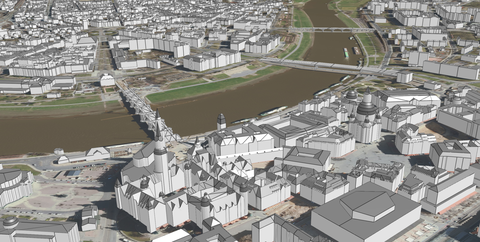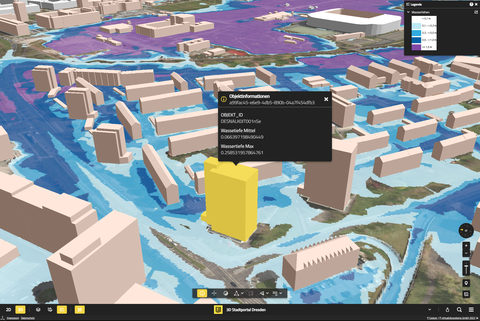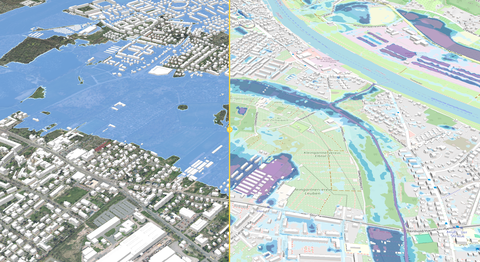Sep 20, 2024
Smart solution for flood protection: TU Dresden researchers develop an app that simulates heavy rainfall

Dresden’s digital twin
Extreme weather phenomena, which now occur regularly due to climate change, pose major challenges for both cities and municipalities. In Dresden, the Institute of Hydraulic Engineering and Technical Hydromechanics is developing an “Urban Digital Heavy Rain Twin” for the Saxon state capital. In the future, the app will make it possible to simulate heavy rainfall, obtain information about hazardous situations, and prepare protective measures on this basis. The prototype, which is based on free and open software, is now available.
As part of the Smart City Dresden pilot project, researchers at the Institute of Hydraulic Engineering and Technical Hydromechanics have been working since May 2024 on the technological and methodological development of a “heavy rain twin:” a virtual model of the city in which geographical data (the topography of Dresden) and municipal information (such as street and building types) are brought together. Once the technical hydrological and hydrodynamic information has been integrated, drainage simulations can be performed using the digital twin, allowing the City of Dresden to benefit from the system in two ways.
“The aim of the project is to create a powerful system that can be used both as an early warning system for heavy rainfall and as a planning tool for adapting to climate change,” explains developer Lars Backhaus.

Monitoring the water level on a building during heavy rainfall
The prototype offers fully automated creation of 2D simulation models, which can be supplemented by precipitation forecasts from Germany's National Meteorological Service. The simulation results provide detailed information on water level as well as the flow velocity in flooded areas. They can also be combined with elements of urban infrastructure such as roads and buildings to enable a precise analysis of potential hazards.
Basic map and area data can be accessed and viewed via a 3D web app for desktop and mobile devices. Users can start heavy rainfall simulations by manually selecting city areas and can track the results in real time. The flood risk can be assessed for the entire urban area, down to individual buildings, to calculate the potential impact and damage. These can support public authorities and private individuals in making informed decisions on flood prevention.

A comparison of affected areas: Medium-risk Elbe flooding (left) and extremely heavy rainfall (right)
Backhaus added that one of the unique features of the system is that the simulation models can be generated quickly and easily based on the city and state database linked in the Urban Digital Twin. This enables the generation of conventional 2D hydrodynamic-numerical simulations for urban areas as well as subsequent 3D simulations of structures such as bridges, which means the city authorities can obtain precise data on the risk of flooding and thus react more quickly in the event of a disaster.
The platform is expected to be open to the public in the second quarter of 2025. The complete development of the Urban Digital Heavy Rain Twin is planned for the end of 2026. Further development beyond this is planned.
About the Model Project Smart City Dresden and Environmental Monitoring/Digital Heavy Rain Twin measure
In the Model Project Smart City Dresden pilot project (2022-2026), which is funded by the federal government, innovative measures are being tested in sample districts of Dresden to improve the city's sustainability, public welfare and quality of life.
The project is managed by the City of Dresden (the city's own IT services company) and works together with TU Dresden in several areas. For example, WISSENSARCHITEKTUR – Laboratory of Knowledge Architecture is responsible for the scientific management of the project. A Business Information Systems research team is investigating the value generation of the urban open data portal. The Environmental Monitoring/Digital Heavy Rain Twin measure is being developed under the direction of the Environmental Office of the City of Dresden (Dr. Katja Maerker) and continues the project funded by the Federal Ministry for the Environment, “Wild runoff water in urban areas” (WAWUR).
Contact
Lars Backhaus M.Sc. (Media Computer Science)
Institute of Hydraulic Engineering and Technical Hydromechanics
Tel: +49 351 463-32262
Email: